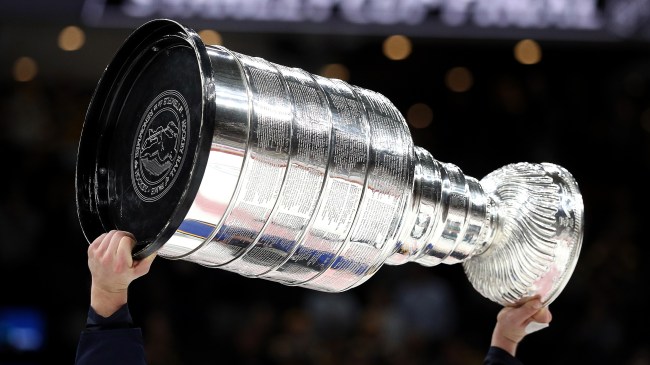
Getty Image
In 1986, the Edmonton Oilers became the first NHL team to secure the Presidents’ Trophy, which was the name given to the new award the league handed out to the franchise that finished with the highest number of points over the course of the regular season.
The nature of that piece of hardware means it’s fair to describe the squad that earns it as “the best team in hockey,” and it seems safe to assume they’ll have an edge on the rest of the competition heading into the Stanley Cup Playoffs.
However, plenty of NHL fans would argue that’s not necessarily the case.
You can talk about the Presidents’ Trophy without discussing the supposed curse many people seem to think shoulders the top team in the league with an invisible burden once the postseason rolls around.
When the Bruins officially clinched the Presidents’ Trophy thanks to their unreal play during the 2022-23 campaign, the folks at SportsCenter wasted no time stirring the pot with a graphic highlighting a trend that’s become increasingly harder to ignore over the past decade.
The Presidents' Trophy has been given out 36 times and only EIGHT of the winners went on to lift The Stanley Cup that same season 👀
Will the Bruins break the curse? 🤔 pic.twitter.com/piRbx2s0IX
— SportsCenter (@SportsCenter) March 31, 2023
However, is it really fair to call it a curse? In order to decide if that’s the case, it’s worth taking a closer look at the numbers and placing the discussion in a larger context.
Does the Presidents’ Trophy Curse really exist?
You could argue no team has befallen this supposed curse to the degree the Tampa Bay Lighting were victimized by the jinx in 2019; the team had put up 128 points while dominating the regular season but were unceremoniously swept by the Blue Jackets in the first round.
However, you could argue that upset is really a testament to the fairly unpredictable nature of the Stanley Cup Playoffs.
Teams are known for turning the intensity and physicality up to the next level once the postseason rolls around, and while success in the regular season can certainly translate to the playoffs once those stakes are raised, most hockey fans know nothing should be taken for granted when Lord Stanley’s trophy is on the line.
The aforementioned tweet also pokes a bit of a hole in its own argument when you consider it notes eight of the teams that have won the Presidents’ Trophy have gone on to win the Stanley Cup.
That means the best team has ended up securing the championship around 23% of the time, which isn’t that shabby when you consider every team that makes the playoffs theoretically has around a 6% chance of winning the Stanley Cup if you remove skill from the equation.
I fully acknowledge examining those odds in a vacuum is a somewhat pointless exercise, but I think most fans would be thrilled to know their team historically has a one-in-four chance of taking home a title.
It’s also worth taking a look at how the best teams in other leagues have fared over the years compared to those in the NHL.
In the NBA, the team with the best record has ended up winning the title 36 times, which amounts to a 42% success rate if you account for seasons where multiple teams were tied at the top of the standings heading into the playoffs.
In the NFL, the success rate is a bit lower, as the team with the best record has won the Super Bowl on 18 occasions (around 32% of the time).
When it comes to the MLB, you could argue baseball teams have been cursed harder than any others, as only 12 of the best have gone on to win the World Series since 1969 (good for close to 23%).
After examining the data, I think it would be somewhat fair to argue the Presidents’ Trophy curse does, in fact, exist—and it will be much easier to take that stance if the Bruins fail to snap it when everything is said and done.
RELATED: Fans Crack Up After The Colorado Avalanche Need Just Ten Minutes To Destroy The Stanley Cup